Muscle Insider
New member
Few exercises compare to the hip thrust when you’re on the mission of building strong and powerful glutes. In the fitness world, the hip thrust has grown in popularity due to the increased understanding of how strong glutes carry over to pretty much every aspect of life, especially performance in sport and the gym. This article breaks down...
The post How to Do Hip Thrusts the Proper Way: Variations and Benefits appeared first on BarBend.
Few exercises compare to the hip thrust when you’re on the mission of building strong and powerful glutes. In the fitness world, the hip thrust has grown in popularity due to the increased understanding of how strong glutes carry over to pretty much every aspect of life, especially performance in sport and the gym.
This article breaks down how to perfect your hip thrust form, their benefits, muscles worked, variations, and mistakes to avoid.
Editor’s Note: The content on BarBend is meant to be informative in nature, but it shouldn’t take the place of advice and/or supervision from a medical professional. The opinions and articles on this site are not intended for use as diagnosis, prevention, and/or treatment of health problems. Speak with your physician if you have any concerns.
Video Guide
You can also check out our in-depth hip thrust guide for more information on the benefits, applications, and variations.
https://youtube.com/watch?v=mYq6-1X3-ngVideo can’t be loaded because JavaScript is disabled: Hip Thrust Guide | Form, Benefits, Variations, and Tips! (https://youtube.com/watch?v=mYq6-1X3-ng)
[Related: The 10 Best Glute Exercises for Strength, Size, and Muscle Activation]
How to Do the Hip Thrust
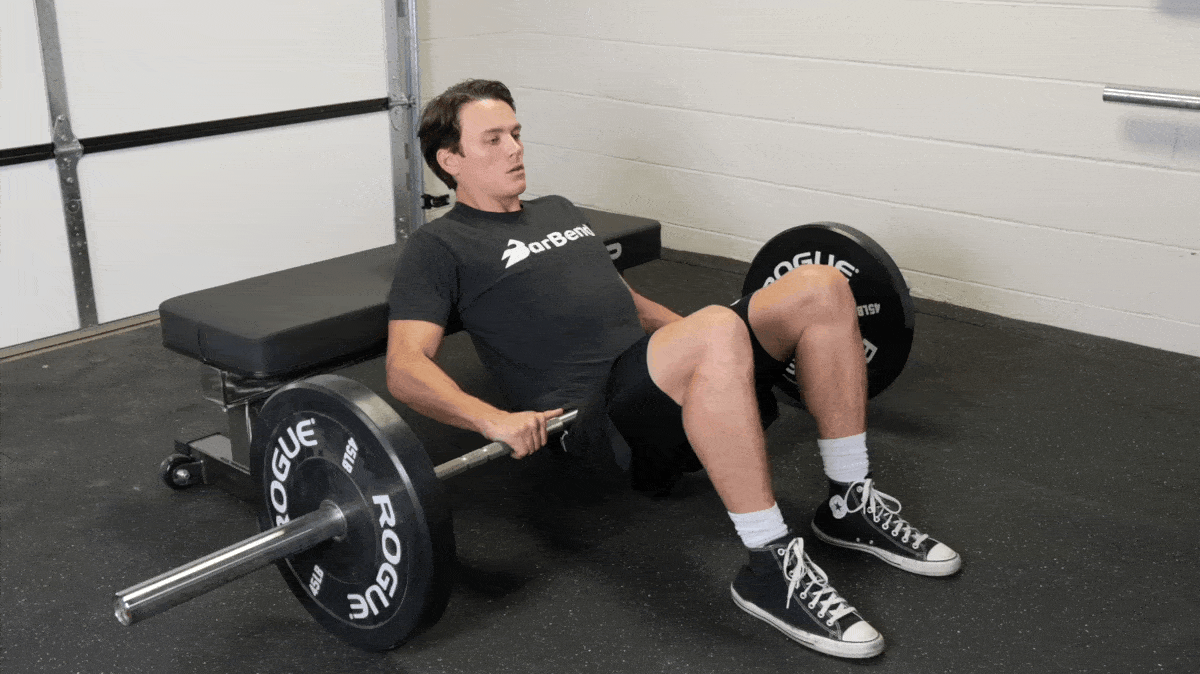
The barbell hip thrust is a fantastic glute-building compound exercise. It allows you to work with a lot of weight, which is crucial for implementing progressive overload. As a bonus, it is one of the few ways to work your posterior chain without putting significant stress onto your lumbar spine.
Equipment Needed: You’ll need a standard barbell, some bumper plates (steel plates will do, but will create some ruckus), a stable weight bench, and something to cushion the bar against your hips like a bar pad or thick towel.
Coach’s Tip: At the top of the hip thrust, your legs should form a 90-degree angle. If they don’t, consider adjusting your foot position.
Hip Thrust Variations
The hip thrust variations below can be great for the beginner working towards the barbell hip thrust, or if you’ve grown a bit tired of using the barbell repeatedly.
Glute Bridge
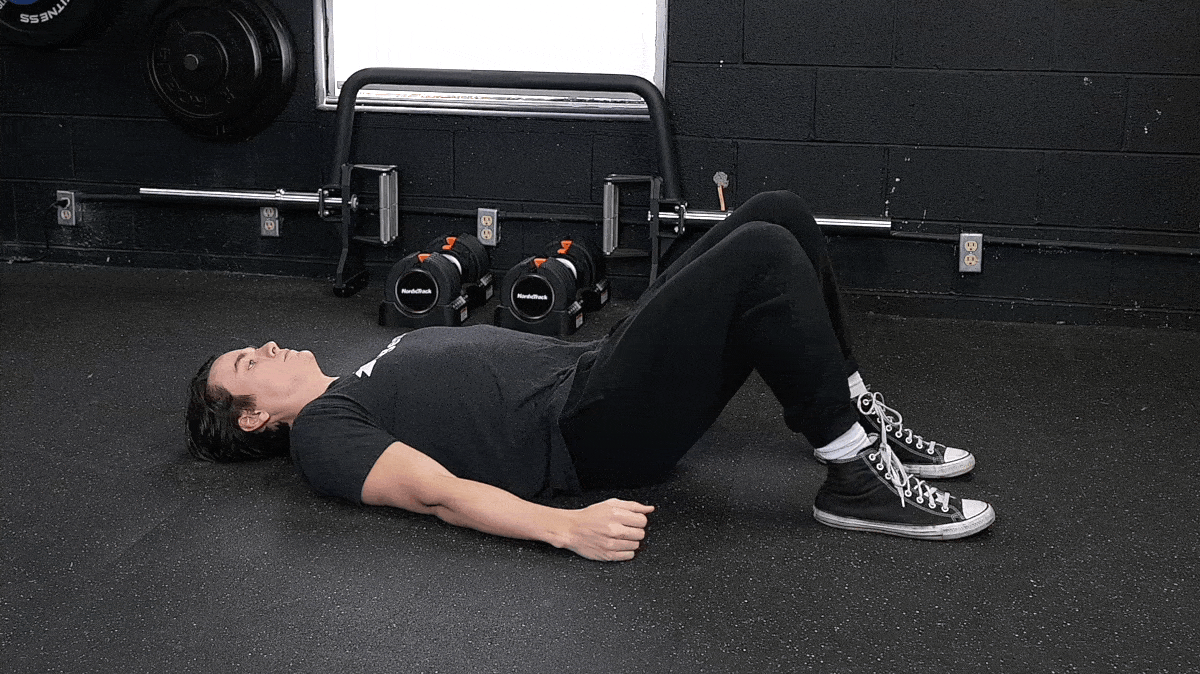
[Read More: The Hip Thrust Mistakes Everyone Keeps Making]
Why Do It: The glute bridge is a bodyweight glute exercise that you can do as part of your dynamic warm-up. It will help you develop a better mind-muscle connection with your backside and prime you for heavier exercises afterward.
Equipment Needed: All you’ll need for this one is a yoga mat and some open space to work.
[*]Lie on your back on the floor with your feet planted on the ground, and knees bent.
[*]From here, exhale and compress your abdomen. Breathe out and push your lower back into the floor.
[*]Then, contract your glutes and push your hips upward until they extend fully.
Dumbbell Hip Thrust
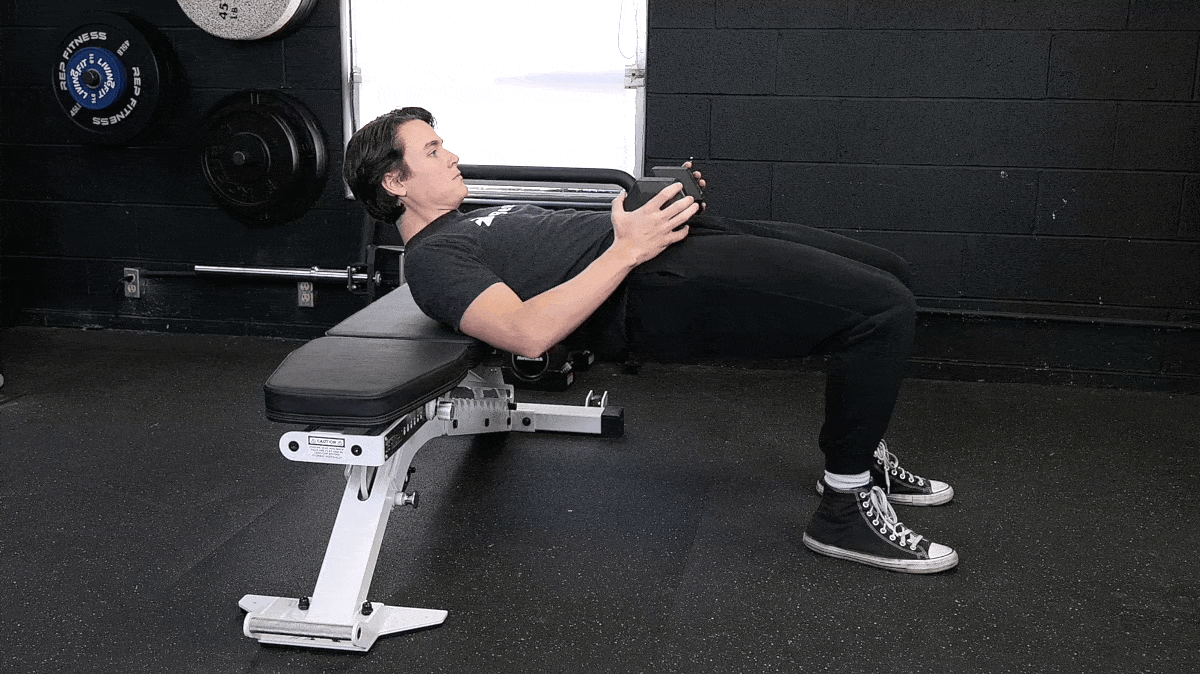
[Read More: Hip Thrust Lessons: 6 Things I Learned from 6 Months of Hip Thrusts]
Why Do It: Dumbbell hip thrusts make for a great substitute if you aren’t ready to use ultra-heavy weights, or you don’t have access to a barbell and need to complete your workout quickly. You can also perform this move from the floor if doing it from a bench doesn’t work for you.
Equipment Needed: You’ll need a weight bench and a medium-to-heavy dumbbell for this exercise.
[*]Set up the same way you would for a barbell hip thrust, but cradle a medium-to-heavy dumbbell in your hips.
[*]Hold the dumbbell’s sides gently to keep it centered. Place your feet firmly on the ground and brace your core.
[*]Push the dumbbell upward with your hips, contracting your glutes until your body forms a straight line.
Single-Leg Glute Bridge
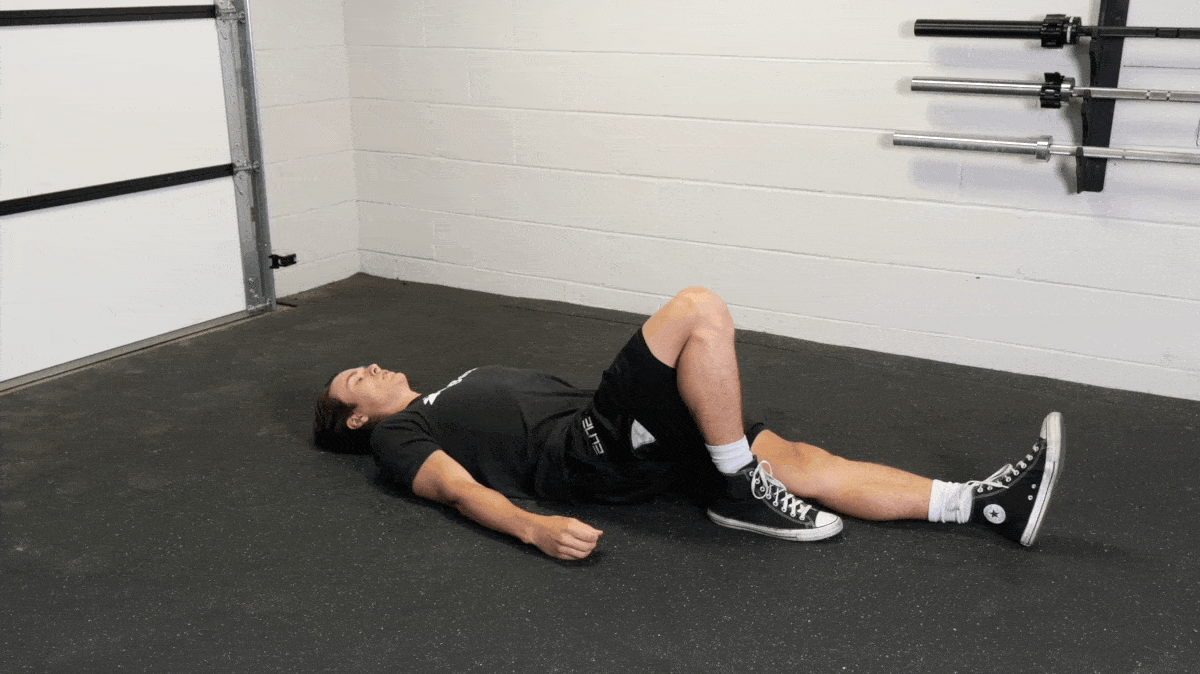
[Read More: Glute Bridge vs. Hip Thrust]
Why Do It: This bridge variation is great for assessing potential imbalances between your left and right glute. You can also use it as a workout finisher to burn your butt to a crisp towards the end of your workout, or as a way to get some extra ab training in on your leg days. For the foot that’s not planted on the ground, bend your knee as much as you need to help you balance.
Equipment Needed: You’ll need a barbell, dumbbell or kettlebell for this exercise. To do the single-leg hip thrust, you’ll need a weight bench or plyo box to sit up against.
[*]Lie on the floor on your back with one leg out straight and the foot of your working leg planted on the ground.
[*]Brace your core and push your lower back into the ground.
[*]You can put your hands on your hips or spread them out on the floor for stability.
[*]Push into the floor with your working leg and extend that hip by squeezing your glute.
[*]
Hip Thrust Alternatives
Below are three bench press variations that do not include a barbell, which can increase unilateral strength and hypertrophy or add variety to a workout program.
Good Morning
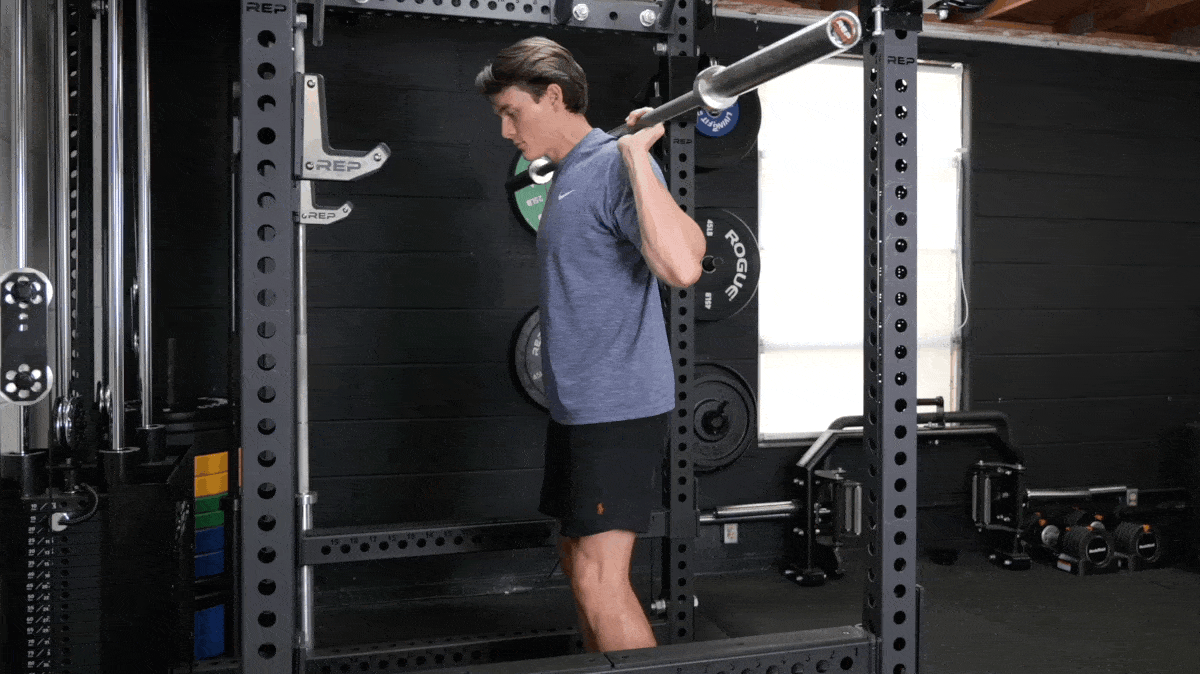
[Read More: Study: How the Back Squat and Hip Thrust Impact 1-RM Strength and Muscle Growth]
Why Do It: Good morning exercises are a viable hip thrust alternative for individuals who do not have any concerns regarding their lower backs. If you’re looking to maximize glute and hamstring growth, good mornings might be for you.
Equipment Needed: You’ll need a barbell, some weight plates (depending on your strength level), and a rack for this exercise.
[*]Unrack a barbell from a squat rack and assume a hip-width stance with your feet pointing mostly forward.
[*]Initiate the move by hinging at the hips and tipping over until you feel a pronounced stretch in your posterior chain, or when your torso is parallel to the ground.
[*]Reverse the motion by squeezing your butt and return to a standing position.
Romanian Deadlift
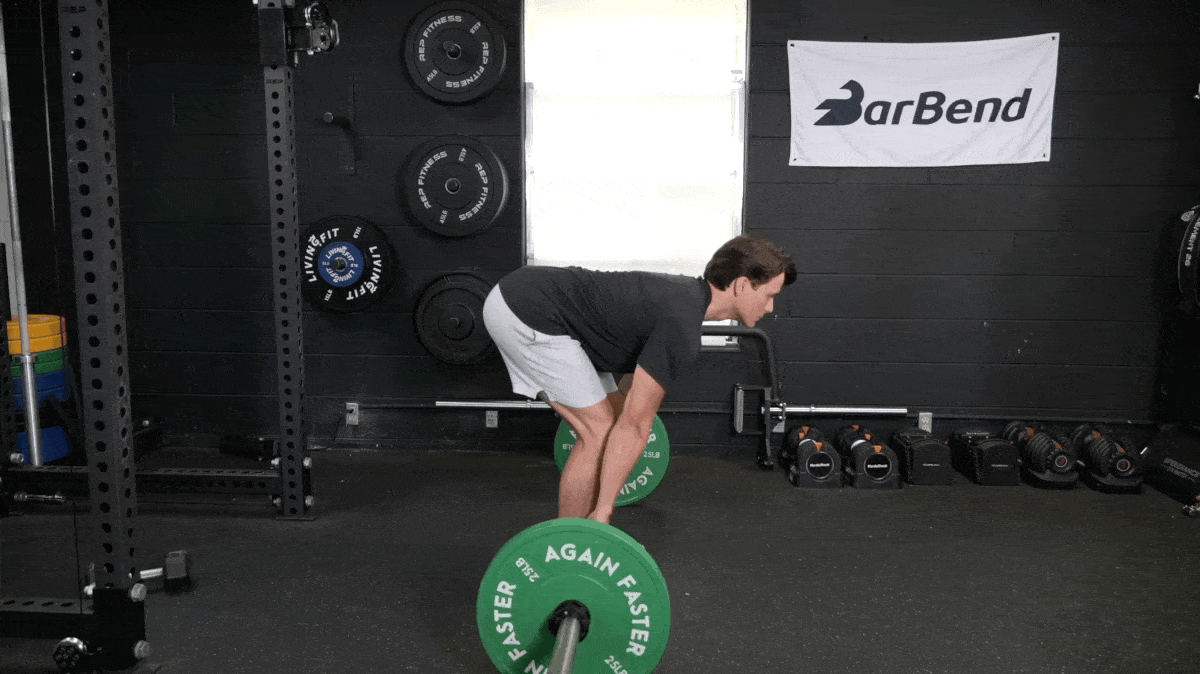
[Read More: 24 Deadlift Variations for Muscle, Strength, Speed, or Grip Strength]
Why Do It: The Romanian deadlift is similar to the hip thrust but places more load onto your hamstrings and lower back than just your glutes alone. Do this one if you need an all-in-one exercise for your posterior chain. You can also assume a sumo stance (wider foot position) to reduce your range of motion.
Equipment Needed: You can do RDLs with a barbell and plates, a pair of medium-to-heavy dumbbells, or even a pair of kettlebells if you’re inclined. You may also want to utilize a weightlifting belt to help you brace your core.
[*]Stand upright with a barbell in your hands using a close grip. Place your feet under your hips with your knees locked and your toes pointed mostly forward.
[*]Take a breath and brace your core, then slowly descend into a hip hinge by pushing your butt backward.
[*]Maintain a neutral spine and allow the bar to glide gently down your thighs. Keep your knees unlocked, but do not bend them intentionally.
[*]Once the bar passes your kneecaps, or you feel a strong stretch in your backside, reverse the motion and stand back up.
Who Should Do the Hip Thrust
The hip thrust is a good glute-focused exercise to increase muscle growth and further hip extension abilities for more complex and compound movements like squats, deadlifts, and even jogging (to name a few). If you fall into one of the following camps, the hip thrust might be for you:
Beginners
Lower-body compound exercises are fantastic for strengthening the musculature in your legs, but movements like the deadlift can be difficult to pick up on the fly. You can perform hip thrusts (or one of their variations) instead to adjust to the demands of strength training before moving on to more involved exercises.
Strength and Power Athletes
The glutes are used in nearly every lift, whether they’re actually moving the weight or bracing to keep you stabilized for another lift.
https://www.youtube.com/watch?v=mPp9B3x6ef0Video can’t be loaded because JavaScript is disabled: Hip Thrust Vs Back Squat | How to Use Each for Your Goals (Research Driven!) (https://www.youtube.com/watch?v=mPp9B3x6ef0)
[Read More: Cable Pull-Through vs. Hip Thrust]
Power and strength athletes alike can benefit from including hip thrusts within a program when they are looking to increase glute growth and support progress for their main competition lifts.
General Populations
Most people spend a lot of time sitting, slouching, and not moving. Learning how to stabilize your spine and extend your hips using your glutes can do wonders for your lower back.
[Read More: The 10 Best Bodyweight Glute Exercises]
In addition to all the benefits above, the hip thrust is a great movement to educate and rebuild general populations so they can progress into more complex and compound movements and human locomotion patterns (running, jumping, sprinting, and standing up).
Who Should Do the Hip Thrust
The hip thrust is a good glute-focused exercise to increase muscle growth and further hip extension abilities for more complex and compound movements like squats, deadlifts, and even jogging (to name a few). If you fall into one of the following camps, the hip thrust might be for you:
Beginners
Lower-body compound exercises are fantastic for strengthening the musculature in your legs, but movements like the deadlift can be difficult to pick up on the fly. You can perform hip thrusts (or one of their variations) instead to adjust to the demands of strength training before moving on to more involved exercises.
Strength and Power Athletes
The glutes are used in nearly every lift, whether they’re actually moving the weight or bracing to keep you stabilized for another lift.
https://www.youtube.com/watch?v=mPp9B3x6ef0Video can’t be loaded because JavaScript is disabled: Hip Thrust Vs Back Squat | How to Use Each for Your Goals (Research Driven!) (https://www.youtube.com/watch?v=mPp9B3x6ef0)
[Read More: Cable Pull-Through vs. Hip Thrust]
Power and strength athletes alike can benefit from including hip thrusts within a program when they are looking to increase glute growth and support progress for their main competition lifts.
General Populations
Most people spend a lot of time sitting, slouching, and not moving. Learning how to stabilize your spine and extend your hips using your glutes can do wonders for your lower back.
[Read More: The 10 Best Bodyweight Glute Exercises]
In addition to all the benefits above, the hip thrust is a great movement to educate and rebuild general populations so they can progress into more complex and compound movements and human locomotion patterns (running, jumping, sprinting, and standing up).
Benefits of the Hip Thrust
Multiple benefits come along with regularly performing hip thrusts. Whether you’re a beginner or a weathered gym rat, there’s a lot of incentive for you to bring hip thrusts into the fold.
Glute Hypertrophy, Strength, and Power
For anyone trying to improve their glute size, strength, and power, the hip thrust is an excellent exercise choice. You can load it heavily using a barbell to increase strength. You can use a lighter dumbbell and pump out a bunch of reps for more glute endurance. Or, you can do them on one leg for unilateral training. Think of the hip thrust as a foundational compound movement — you can program it for any goal.
Easy to Scale
Another benefit of the hip thrust is that it’s easy to scale for various fitness levels. You can use implements like dumbbells and even your own body weight to obtain hip thrust benefits. They’re accessible to both beginners and advanced trainees and can have a place in anyone’s program.
Great for Warming Up
Outside of training adaptation benefits, the hip thrust is a fantastic movement to warm up and cool down. The hip thrust can be performed with just your body weight and at lighter intensities to prime the body for optimal hip extension. You can also do them at the end of a workout as a way to really fry the glutes.
Muscles Worked by the Hip Thrust
What do hip thrusts work? To no surprise, the hip thrust trains the glutes primarily and has some training benefits for your quads, adductors, and hamstrings as well. Check out what muscles hip thrusts work.
Glutes
The glutes are the primary mover during hip thrust, with your gluteus maximus handling most of the demands. Your gluteus medius is also active and assists in hip extension and stabilizing your pelvis so that your gluteus maximus can work to extend your hips.
Hamstrings
Your hamstrings work to keep your knee fixed throughout the movement and are acting isometrically to hold your knees at roughly 90 degrees of flexion. Some lifters may get some light or even moderate hamstring contractions as they extend their hips.
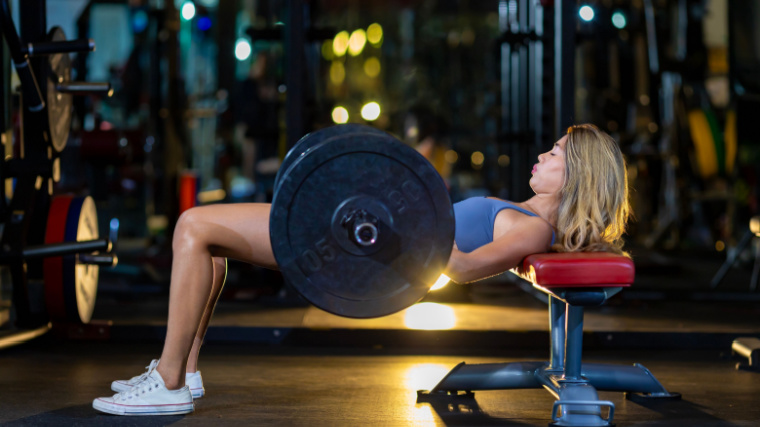 Credit: Akarawut / Shutterstock
Credit: Akarawut / Shutterstock
[Read More: Hip Thrust Vs. Back Squat for Glute Development]
However, if it becomes too much, there is a strong chance they are not extending their hips fully and/or their knees are not bent enough. You want to feel your hamstrings only a little during the movement.
Adductors
The adductors are muscles of your inner groin that work isometrically to stabilize the pelvis during hip extension. If you want to increase the activation of your hip adductors, you can also place a foam roller between your thighs and compress the roller isometrically as you extend your hips.
Common Hip Thrust Mistakes
The hip thrust is a mainstay in a lot of lifters’ programs. But that doesn’t mean everyone does it right. Make sure your hip thrust form is on point by looking out for these common training mistakes.
Feet Too Close to the Butt
The first mistake is bringing your feet too close to your butt. Ideally, you want to create a 90-degree angle at the knee when the hips are in full extension. If your feet are too close to your butt, then your hip extension will be limited. That will be uncomfortable on your knees.
Overly Extending the Lower Back
Another common mistake of some beginners is extending the lumbar in compensation for hip extension. If you find that your lower back is getting sore from hip thrusts routinely, then it might be a sign to drop the weight and work on hip extension mechanics. When performing the hip thrust, think about keeping your rib cage down and avoid letting it flare at the top when achieving hip extension.
Thrust It Up
When you’re chasing massive glute gains, the hip thrust is a great way to get there. You’ll be teaching your body to align itself under pressure from a barbell, using your hip drive to keep your knees, hips, and shoulders aligned. That’s a valuable skill to have when you want to pull off a max deadlift. Plus, you’ll be packing muscle onto your backside in case you’re looking to up your jean size. Put that all together, and the hip thrust is a win-win for strength and muscle-building.
FAQs
Still have questions about the classic hip thrust? Cool. We’ve got answers.
How much weight should you use for hip thrusts?[/b] If you are using a weight in which you cannot feel the glutes working, then you’re probably going too light. Or, if you feel yourself struggling and your form breaking down, then reduce the load you’re using.
How can you progress hip thrusts without adding more weight?[/b] The glutes are the biggest muscle group in the body and are roughly equal parts fast and slow-twitch muscle fibers. That said, increasing the weight is often a great way to progress glute strength and muscle hypertrophy. However, it is not the only way.
If you are limited by the amount of weight you have access to, you can also incorporate tempos, increased ranges of motion (hip flexion), and short rest periods to increase metabolite build-up and muscular fatigue. You can also play around with exercise order or pair these with more compound exercises like squats to further increase muscle breakdown.
Are hip thrusts good for people who have lower back pain?[/b] Developing glute strength is a good place to start when looking to decrease lower back pain and stiffness. Weak glutes often lead to poor posture, excessive lumbar extension (lacking the ability to extend your hips), and injury when performing movements like deadlifts, squats, lunges, etc.
If you are someone who struggles with lower back pain, try performing glute bridges from the floor and holding these for 20 to 30 seconds at a time. As you progress, you can perform hip thrusts with body weight and with existential loading, making sure to use the glutes to lift the load rather than simply arching the back.
If you have pain, consult a doctor before starting an exercise routine.
The post How to Do Hip Thrusts the Proper Way: Variations and Benefits appeared first on BarBend.
Click here to view the article.
The post How to Do Hip Thrusts the Proper Way: Variations and Benefits appeared first on BarBend.
Few exercises compare to the hip thrust when you’re on the mission of building strong and powerful glutes. In the fitness world, the hip thrust has grown in popularity due to the increased understanding of how strong glutes carry over to pretty much every aspect of life, especially performance in sport and the gym.
This article breaks down how to perfect your hip thrust form, their benefits, muscles worked, variations, and mistakes to avoid.
Editor’s Note: The content on BarBend is meant to be informative in nature, but it shouldn’t take the place of advice and/or supervision from a medical professional. The opinions and articles on this site are not intended for use as diagnosis, prevention, and/or treatment of health problems. Speak with your physician if you have any concerns.
Video Guide
You can also check out our in-depth hip thrust guide for more information on the benefits, applications, and variations.
https://youtube.com/watch?v=mYq6-1X3-ngVideo can’t be loaded because JavaScript is disabled: Hip Thrust Guide | Form, Benefits, Variations, and Tips! (https://youtube.com/watch?v=mYq6-1X3-ng)
[Related: The 10 Best Glute Exercises for Strength, Size, and Muscle Activation]
How to Do the Hip Thrust

The barbell hip thrust is a fantastic glute-building compound exercise. It allows you to work with a lot of weight, which is crucial for implementing progressive overload. As a bonus, it is one of the few ways to work your posterior chain without putting significant stress onto your lumbar spine.
Equipment Needed: You’ll need a standard barbell, some bumper plates (steel plates will do, but will create some ruckus), a stable weight bench, and something to cushion the bar against your hips like a bar pad or thick towel.
- Step 1: Sit with your back up against the edge of a bench that’s parallel to you. Roll a loaded barbell into the crease of your hips (you can wrap a towel or squat pad around the bar to make it more comfortable).
- Step 2: Once the barbell is secure in the hip crease, drive your feet down — which should be planted firmly on the ground so that your legs are bent — and drive your back towards the bench.
- Step 3: Once you are set, pull your belly tight and keep your back flat. Lock your torso in so that the hips move up and down, almost as if your torso is a lever.
- Step 4: Contract your glutes to push your hips upward until they lock out fully. Your body should form a straight line from your shoulders to your knees.
Coach’s Tip: At the top of the hip thrust, your legs should form a 90-degree angle. If they don’t, consider adjusting your foot position.
Hip Thrust Variations
The hip thrust variations below can be great for the beginner working towards the barbell hip thrust, or if you’ve grown a bit tired of using the barbell repeatedly.
Glute Bridge

[Read More: The Hip Thrust Mistakes Everyone Keeps Making]
Why Do It: The glute bridge is a bodyweight glute exercise that you can do as part of your dynamic warm-up. It will help you develop a better mind-muscle connection with your backside and prime you for heavier exercises afterward.
Equipment Needed: All you’ll need for this one is a yoga mat and some open space to work.
[*]Lie on your back on the floor with your feet planted on the ground, and knees bent.
[*]From here, exhale and compress your abdomen. Breathe out and push your lower back into the floor.
[*]Then, contract your glutes and push your hips upward until they extend fully.
Dumbbell Hip Thrust

[Read More: Hip Thrust Lessons: 6 Things I Learned from 6 Months of Hip Thrusts]
Why Do It: Dumbbell hip thrusts make for a great substitute if you aren’t ready to use ultra-heavy weights, or you don’t have access to a barbell and need to complete your workout quickly. You can also perform this move from the floor if doing it from a bench doesn’t work for you.
Equipment Needed: You’ll need a weight bench and a medium-to-heavy dumbbell for this exercise.
[*]Set up the same way you would for a barbell hip thrust, but cradle a medium-to-heavy dumbbell in your hips.
[*]Hold the dumbbell’s sides gently to keep it centered. Place your feet firmly on the ground and brace your core.
[*]Push the dumbbell upward with your hips, contracting your glutes until your body forms a straight line.
Single-Leg Glute Bridge

[Read More: Glute Bridge vs. Hip Thrust]
Why Do It: This bridge variation is great for assessing potential imbalances between your left and right glute. You can also use it as a workout finisher to burn your butt to a crisp towards the end of your workout, or as a way to get some extra ab training in on your leg days. For the foot that’s not planted on the ground, bend your knee as much as you need to help you balance.
Equipment Needed: You’ll need a barbell, dumbbell or kettlebell for this exercise. To do the single-leg hip thrust, you’ll need a weight bench or plyo box to sit up against.
[*]Lie on the floor on your back with one leg out straight and the foot of your working leg planted on the ground.
[*]Brace your core and push your lower back into the ground.
[*]You can put your hands on your hips or spread them out on the floor for stability.
[*]Push into the floor with your working leg and extend that hip by squeezing your glute.
[*]
Hip Thrust Alternatives
Below are three bench press variations that do not include a barbell, which can increase unilateral strength and hypertrophy or add variety to a workout program.
Good Morning

[Read More: Study: How the Back Squat and Hip Thrust Impact 1-RM Strength and Muscle Growth]
Why Do It: Good morning exercises are a viable hip thrust alternative for individuals who do not have any concerns regarding their lower backs. If you’re looking to maximize glute and hamstring growth, good mornings might be for you.
Equipment Needed: You’ll need a barbell, some weight plates (depending on your strength level), and a rack for this exercise.
[*]Unrack a barbell from a squat rack and assume a hip-width stance with your feet pointing mostly forward.
[*]Initiate the move by hinging at the hips and tipping over until you feel a pronounced stretch in your posterior chain, or when your torso is parallel to the ground.
[*]Reverse the motion by squeezing your butt and return to a standing position.
Romanian Deadlift

[Read More: 24 Deadlift Variations for Muscle, Strength, Speed, or Grip Strength]
Why Do It: The Romanian deadlift is similar to the hip thrust but places more load onto your hamstrings and lower back than just your glutes alone. Do this one if you need an all-in-one exercise for your posterior chain. You can also assume a sumo stance (wider foot position) to reduce your range of motion.
Equipment Needed: You can do RDLs with a barbell and plates, a pair of medium-to-heavy dumbbells, or even a pair of kettlebells if you’re inclined. You may also want to utilize a weightlifting belt to help you brace your core.
[*]Stand upright with a barbell in your hands using a close grip. Place your feet under your hips with your knees locked and your toes pointed mostly forward.
[*]Take a breath and brace your core, then slowly descend into a hip hinge by pushing your butt backward.
[*]Maintain a neutral spine and allow the bar to glide gently down your thighs. Keep your knees unlocked, but do not bend them intentionally.
[*]Once the bar passes your kneecaps, or you feel a strong stretch in your backside, reverse the motion and stand back up.
Who Should Do the Hip Thrust
The hip thrust is a good glute-focused exercise to increase muscle growth and further hip extension abilities for more complex and compound movements like squats, deadlifts, and even jogging (to name a few). If you fall into one of the following camps, the hip thrust might be for you:
Beginners
Lower-body compound exercises are fantastic for strengthening the musculature in your legs, but movements like the deadlift can be difficult to pick up on the fly. You can perform hip thrusts (or one of their variations) instead to adjust to the demands of strength training before moving on to more involved exercises.
Strength and Power Athletes
The glutes are used in nearly every lift, whether they’re actually moving the weight or bracing to keep you stabilized for another lift.
https://www.youtube.com/watch?v=mPp9B3x6ef0Video can’t be loaded because JavaScript is disabled: Hip Thrust Vs Back Squat | How to Use Each for Your Goals (Research Driven!) (https://www.youtube.com/watch?v=mPp9B3x6ef0)
[Read More: Cable Pull-Through vs. Hip Thrust]
Power and strength athletes alike can benefit from including hip thrusts within a program when they are looking to increase glute growth and support progress for their main competition lifts.
General Populations
Most people spend a lot of time sitting, slouching, and not moving. Learning how to stabilize your spine and extend your hips using your glutes can do wonders for your lower back.
[Read More: The 10 Best Bodyweight Glute Exercises]
In addition to all the benefits above, the hip thrust is a great movement to educate and rebuild general populations so they can progress into more complex and compound movements and human locomotion patterns (running, jumping, sprinting, and standing up).
Who Should Do the Hip Thrust
The hip thrust is a good glute-focused exercise to increase muscle growth and further hip extension abilities for more complex and compound movements like squats, deadlifts, and even jogging (to name a few). If you fall into one of the following camps, the hip thrust might be for you:
Beginners
Lower-body compound exercises are fantastic for strengthening the musculature in your legs, but movements like the deadlift can be difficult to pick up on the fly. You can perform hip thrusts (or one of their variations) instead to adjust to the demands of strength training before moving on to more involved exercises.
Strength and Power Athletes
The glutes are used in nearly every lift, whether they’re actually moving the weight or bracing to keep you stabilized for another lift.
https://www.youtube.com/watch?v=mPp9B3x6ef0Video can’t be loaded because JavaScript is disabled: Hip Thrust Vs Back Squat | How to Use Each for Your Goals (Research Driven!) (https://www.youtube.com/watch?v=mPp9B3x6ef0)
[Read More: Cable Pull-Through vs. Hip Thrust]
Power and strength athletes alike can benefit from including hip thrusts within a program when they are looking to increase glute growth and support progress for their main competition lifts.
General Populations
Most people spend a lot of time sitting, slouching, and not moving. Learning how to stabilize your spine and extend your hips using your glutes can do wonders for your lower back.
[Read More: The 10 Best Bodyweight Glute Exercises]
In addition to all the benefits above, the hip thrust is a great movement to educate and rebuild general populations so they can progress into more complex and compound movements and human locomotion patterns (running, jumping, sprinting, and standing up).
Benefits of the Hip Thrust
Multiple benefits come along with regularly performing hip thrusts. Whether you’re a beginner or a weathered gym rat, there’s a lot of incentive for you to bring hip thrusts into the fold.
Glute Hypertrophy, Strength, and Power
For anyone trying to improve their glute size, strength, and power, the hip thrust is an excellent exercise choice. You can load it heavily using a barbell to increase strength. You can use a lighter dumbbell and pump out a bunch of reps for more glute endurance. Or, you can do them on one leg for unilateral training. Think of the hip thrust as a foundational compound movement — you can program it for any goal.
Easy to Scale
Another benefit of the hip thrust is that it’s easy to scale for various fitness levels. You can use implements like dumbbells and even your own body weight to obtain hip thrust benefits. They’re accessible to both beginners and advanced trainees and can have a place in anyone’s program.
Great for Warming Up
Outside of training adaptation benefits, the hip thrust is a fantastic movement to warm up and cool down. The hip thrust can be performed with just your body weight and at lighter intensities to prime the body for optimal hip extension. You can also do them at the end of a workout as a way to really fry the glutes.
Muscles Worked by the Hip Thrust
What do hip thrusts work? To no surprise, the hip thrust trains the glutes primarily and has some training benefits for your quads, adductors, and hamstrings as well. Check out what muscles hip thrusts work.
Glutes
The glutes are the primary mover during hip thrust, with your gluteus maximus handling most of the demands. Your gluteus medius is also active and assists in hip extension and stabilizing your pelvis so that your gluteus maximus can work to extend your hips.
Hamstrings
Your hamstrings work to keep your knee fixed throughout the movement and are acting isometrically to hold your knees at roughly 90 degrees of flexion. Some lifters may get some light or even moderate hamstring contractions as they extend their hips.

[Read More: Hip Thrust Vs. Back Squat for Glute Development]
However, if it becomes too much, there is a strong chance they are not extending their hips fully and/or their knees are not bent enough. You want to feel your hamstrings only a little during the movement.
Adductors
The adductors are muscles of your inner groin that work isometrically to stabilize the pelvis during hip extension. If you want to increase the activation of your hip adductors, you can also place a foam roller between your thighs and compress the roller isometrically as you extend your hips.
Common Hip Thrust Mistakes
The hip thrust is a mainstay in a lot of lifters’ programs. But that doesn’t mean everyone does it right. Make sure your hip thrust form is on point by looking out for these common training mistakes.
Feet Too Close to the Butt
The first mistake is bringing your feet too close to your butt. Ideally, you want to create a 90-degree angle at the knee when the hips are in full extension. If your feet are too close to your butt, then your hip extension will be limited. That will be uncomfortable on your knees.
Overly Extending the Lower Back
Another common mistake of some beginners is extending the lumbar in compensation for hip extension. If you find that your lower back is getting sore from hip thrusts routinely, then it might be a sign to drop the weight and work on hip extension mechanics. When performing the hip thrust, think about keeping your rib cage down and avoid letting it flare at the top when achieving hip extension.
Thrust It Up
When you’re chasing massive glute gains, the hip thrust is a great way to get there. You’ll be teaching your body to align itself under pressure from a barbell, using your hip drive to keep your knees, hips, and shoulders aligned. That’s a valuable skill to have when you want to pull off a max deadlift. Plus, you’ll be packing muscle onto your backside in case you’re looking to up your jean size. Put that all together, and the hip thrust is a win-win for strength and muscle-building.
FAQs
Still have questions about the classic hip thrust? Cool. We’ve got answers.
How much weight should you use for hip thrusts?[/b] If you are using a weight in which you cannot feel the glutes working, then you’re probably going too light. Or, if you feel yourself struggling and your form breaking down, then reduce the load you’re using.
How can you progress hip thrusts without adding more weight?[/b] The glutes are the biggest muscle group in the body and are roughly equal parts fast and slow-twitch muscle fibers. That said, increasing the weight is often a great way to progress glute strength and muscle hypertrophy. However, it is not the only way.
If you are limited by the amount of weight you have access to, you can also incorporate tempos, increased ranges of motion (hip flexion), and short rest periods to increase metabolite build-up and muscular fatigue. You can also play around with exercise order or pair these with more compound exercises like squats to further increase muscle breakdown.
Are hip thrusts good for people who have lower back pain?[/b] Developing glute strength is a good place to start when looking to decrease lower back pain and stiffness. Weak glutes often lead to poor posture, excessive lumbar extension (lacking the ability to extend your hips), and injury when performing movements like deadlifts, squats, lunges, etc.
If you are someone who struggles with lower back pain, try performing glute bridges from the floor and holding these for 20 to 30 seconds at a time. As you progress, you can perform hip thrusts with body weight and with existential loading, making sure to use the glutes to lift the load rather than simply arching the back.
If you have pain, consult a doctor before starting an exercise routine.
The post How to Do Hip Thrusts the Proper Way: Variations and Benefits appeared first on BarBend.
Click here to view the article.



